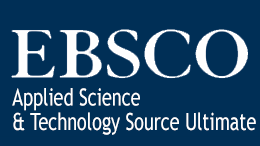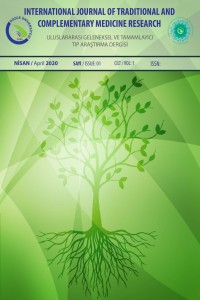Research Article
Abstract
References
- 1. Baydar SN. Şifalı bitkiler Ansiklopedisi: modern tıp alternatif tıp ile elele: Palme Yayıncılık; 2006. 2. Altunbaş M, Türel İ. Petroselinum crispum (maydanoz) tohumu uçucu yağ özütünün letal doz düzeyleri ve antienflamatuvar aktivitesinin deney hayvanları üzerinde araştırılması. Yüzüncü Yıl Üniversitesi Veteriner Fakültesi Dergisi. 2009;20(1):21-25. 3. Fulder S. The handbook of alternative and complementary medicine: Oxford University Press, USA; 1996. 4. Yonar T, Kurt A. Treatability studies of hospital wastewaters with AOPs by Taguchi’s experimental design. Glob Nest J. 2017;19:505-510. 5. Vergili İ, Kaya Y, Gönder Z, Barlas H. İlaç aktif maddelerinin sucul çevrede bulunuşları, davranışları ve etkileri. Türk Sucul Yaşam Dergisi. 2005;4:284-291. 6. Kurt A, Yonar T. Endokrin Bozucu Antibiyotik Bileşiklerinin UV/H2O2 Prosesi ile Taguchi Deneysel Dizaynına Göre Arıtılabilirliği. Afyon Kocatepe Üniversitesi Fen Ve Mühendislik Bilimleri Dergisi. 2016;17(2):854-860. 7. Arslan-Alaton I, Dogruel S. Pre-treatment of penicillin formulation effluent by advanced oxidation processes. Journal of hazardous materials. 2004;112(1-2):105-113. 8. Kurt A, Mert BK, Özengin N, Sivrioğlu Ö, Yonar T. Treatment of antibiotics in wastewater using advanced oxidation processes (AOPs). Physico-Chemical Wastewater Treatment and Resource Recovery. 2017:175. 9. Aslan R. Hekimlikte Alternatif ve Tamamlayıcı Tıbbi Yaklaşımlar. Kocatepe Vet J 9 (4): 363. 2016;371. 10. Baytop T. Türkiye'de bitkiler ile tedavi: geçmişte ve bugün: Nobel Tıp Kitabevleri; 1999. 11. Yasar M. The remember regeneration therapy method: An overview of new therapy protocol to approach diseases. Journal of Complementary Medicine Research. 2019;10(1):68-80. 12. Kayaalp O. Klinik farmakolojinin esasları ve temel düzenlemeler: Pelikan Yayıncılık; 2008. 13. Monga M, Sausville E. Developmental therapeutics program at the NCI: molecular target and drug discovery process. Leukemia. 2002;16(4):520. 14. Saygi Ş. Deneysel Toksikolojide Toksisite Testleri ve Test Sonuçlarinin Önemi. Gülhane Tıp Dergisi (GTD) Gülhane Medical Journal (GMJ). 2003:291. 15. Mascolo N, Jain R, Jain S, Capasso F. Ethnopharmacologic investigation of ginger (Zingiber officinale). Journal of ethnopharmacology. 1989;27(1-2):129-140. 16. Fachini-Queiroz FC, Kummer R, Estevao-Silva CF, et al. Effects of thymol and carvacrol, constituents of Thymus vulgaris L. essential oil, on the inflammatory response. Evidence-Based Complementary and Alternative Medicine. 2012;2012. 17. Bais S, Gill NS, Rana N, Shandil S. A phytopharmacological review on a medicinal plant: Juniperus communis. International scholarly research notices. 2014;2014. 18. Salih P, Kaplan EN, Çakı MN. Lavandula Stoechas (Karabaş Otu) Bitki Özütünden Kozmetik Ürün Eldesi. Uluslararası Batı Karadeniz Mühendislik ve Fen Bilimleri Dergisi.1(1):24-37. 19. Wallin RF, Arscott E. A practical guide to ISO 10993-5: Cytotoxicity. Medical Device and Diagnostic Industry. 1998;20:96-98. 20. Altundag E, Ozturk M. Ethnomedicinal studies on the plant resources of east Anatolia, Turkey. Procedia-Social and Behavioral Sciences. 2011;19:756-777. 21. Bölgesi MY, Akdeniz B. TIBBİ VE AROMATİK BİTKİLER SEKTÖR RAPORU. 22. Akdogan M, Koyu A, Ciris M, Yildiz K. Anti-hypercholesterolemic activity of Juniperus communis Lynn Oil in rats: A biochemical and histopathological investigation. 2012. 23. Korkmaz M. Kelkit (Gümüşhane) aktarlarında satılan tıbbi bitkilerin etnobotanik özellikleri. Süleyman Demirel Üniversitesi Fen Bilimleri Enstitüsü Dergisi. 2014;18(3):60-80. 24. Chunlaratthanaphorn S, Lertprasertsuke N, Ngamjariyawat USATA, Suwanlikhid N, Jaijoy K. Acute and subchronic toxicity study of the water extract from dried fruits of Piper nigrum L. in rats. health. 2007;29:109-124. 25. Weidner MS, Sigwart K. Investigation of the teratogenic potential of a Zingiber officinale extract in the rat. Reproductive Toxicology. 2000;15(1):75-80. 26. Kagramanov K. Effect of the essential oils of some thyme growing in Azerbaidzhan on cardiovascular activity and respiration. Azerbaidzhanskii Meditsinskii Zhurnal. 1977;54(5):49-51. 27. Skramlik E. Toxicity and toleration of volatile oils. Pharmazie. 1959;14:435-445. 28. Yassine EZ, Dalila B, El MansouriLatifa BS, Lebtar S, Sanae A, Abdellah F. Phytochemical Screening, Anti-inflammatory Activity and Acute Toxicity of Hydro-ethanolic, Flavonoid, Tannin and Mucilage Extracts of Lavandula stoechas L. from Morocco. Int J Pharm Phytochem Res. 2016;8(1):31-37. 29. Thorup I, Würtzen G, Carstensen J, Olsen P. Short term toxicity study in rats dosed with peppermint oil. Toxicology letters. 1983;19(3):211-215.
Effect of My Guard® Food Supplement on Acute and Subacute Toxicity on Rats
Abstract
Objective: Today, in the field of traditional and complementary medicine, there has been a serious interest in medicinal plants and the treatment methods performed with the use of these plants. The use of natural resources in drug production studies and the promotion of these uses led to the advantage of reaching the drug at a reasonable cost with a rational method. However, these studies should be carried out with objective practices within the framework of scientific ethical rules. Investigating the toxicity dimension in studies related to the subject is also very important for human health to use these products. For this reason, the aim of the study is to determine the toxic symptoms of the My Guard® herbal mixture syrup which is a product used in the remember regeneration therapy method.
Material-Method: In the experimental design, there were 4 groups (1 control and 3 application groups). To observe acute and subacute toxicity, clinical observation, the biochemical, hematological and histopathological parameters of the animals were evaluated at the end of the application times.
Results: According to the results obtained from the study, there were not found significant differences in biochemical, hematological and histopathological evaluations between the control and the application groups.
Conclusion: In our study, the toxic effects of My Guard® product in the dose mentioned in acute and subacute periods were not observed.
Material-Method: In the experimental design, there were 4 groups (1 control and 3 application groups). To observe acute and subacute toxicity, clinical observation, the biochemical, hematological and histopathological parameters of the animals were evaluated at the end of the application times.
Results: According to the results obtained from the study, there were not found significant differences in biochemical, hematological and histopathological evaluations between the control and the application groups.
Conclusion: In our study, the toxic effects of My Guard® product in the dose mentioned in acute and subacute periods were not observed.
References
- 1. Baydar SN. Şifalı bitkiler Ansiklopedisi: modern tıp alternatif tıp ile elele: Palme Yayıncılık; 2006. 2. Altunbaş M, Türel İ. Petroselinum crispum (maydanoz) tohumu uçucu yağ özütünün letal doz düzeyleri ve antienflamatuvar aktivitesinin deney hayvanları üzerinde araştırılması. Yüzüncü Yıl Üniversitesi Veteriner Fakültesi Dergisi. 2009;20(1):21-25. 3. Fulder S. The handbook of alternative and complementary medicine: Oxford University Press, USA; 1996. 4. Yonar T, Kurt A. Treatability studies of hospital wastewaters with AOPs by Taguchi’s experimental design. Glob Nest J. 2017;19:505-510. 5. Vergili İ, Kaya Y, Gönder Z, Barlas H. İlaç aktif maddelerinin sucul çevrede bulunuşları, davranışları ve etkileri. Türk Sucul Yaşam Dergisi. 2005;4:284-291. 6. Kurt A, Yonar T. Endokrin Bozucu Antibiyotik Bileşiklerinin UV/H2O2 Prosesi ile Taguchi Deneysel Dizaynına Göre Arıtılabilirliği. Afyon Kocatepe Üniversitesi Fen Ve Mühendislik Bilimleri Dergisi. 2016;17(2):854-860. 7. Arslan-Alaton I, Dogruel S. Pre-treatment of penicillin formulation effluent by advanced oxidation processes. Journal of hazardous materials. 2004;112(1-2):105-113. 8. Kurt A, Mert BK, Özengin N, Sivrioğlu Ö, Yonar T. Treatment of antibiotics in wastewater using advanced oxidation processes (AOPs). Physico-Chemical Wastewater Treatment and Resource Recovery. 2017:175. 9. Aslan R. Hekimlikte Alternatif ve Tamamlayıcı Tıbbi Yaklaşımlar. Kocatepe Vet J 9 (4): 363. 2016;371. 10. Baytop T. Türkiye'de bitkiler ile tedavi: geçmişte ve bugün: Nobel Tıp Kitabevleri; 1999. 11. Yasar M. The remember regeneration therapy method: An overview of new therapy protocol to approach diseases. Journal of Complementary Medicine Research. 2019;10(1):68-80. 12. Kayaalp O. Klinik farmakolojinin esasları ve temel düzenlemeler: Pelikan Yayıncılık; 2008. 13. Monga M, Sausville E. Developmental therapeutics program at the NCI: molecular target and drug discovery process. Leukemia. 2002;16(4):520. 14. Saygi Ş. Deneysel Toksikolojide Toksisite Testleri ve Test Sonuçlarinin Önemi. Gülhane Tıp Dergisi (GTD) Gülhane Medical Journal (GMJ). 2003:291. 15. Mascolo N, Jain R, Jain S, Capasso F. Ethnopharmacologic investigation of ginger (Zingiber officinale). Journal of ethnopharmacology. 1989;27(1-2):129-140. 16. Fachini-Queiroz FC, Kummer R, Estevao-Silva CF, et al. Effects of thymol and carvacrol, constituents of Thymus vulgaris L. essential oil, on the inflammatory response. Evidence-Based Complementary and Alternative Medicine. 2012;2012. 17. Bais S, Gill NS, Rana N, Shandil S. A phytopharmacological review on a medicinal plant: Juniperus communis. International scholarly research notices. 2014;2014. 18. Salih P, Kaplan EN, Çakı MN. Lavandula Stoechas (Karabaş Otu) Bitki Özütünden Kozmetik Ürün Eldesi. Uluslararası Batı Karadeniz Mühendislik ve Fen Bilimleri Dergisi.1(1):24-37. 19. Wallin RF, Arscott E. A practical guide to ISO 10993-5: Cytotoxicity. Medical Device and Diagnostic Industry. 1998;20:96-98. 20. Altundag E, Ozturk M. Ethnomedicinal studies on the plant resources of east Anatolia, Turkey. Procedia-Social and Behavioral Sciences. 2011;19:756-777. 21. Bölgesi MY, Akdeniz B. TIBBİ VE AROMATİK BİTKİLER SEKTÖR RAPORU. 22. Akdogan M, Koyu A, Ciris M, Yildiz K. Anti-hypercholesterolemic activity of Juniperus communis Lynn Oil in rats: A biochemical and histopathological investigation. 2012. 23. Korkmaz M. Kelkit (Gümüşhane) aktarlarında satılan tıbbi bitkilerin etnobotanik özellikleri. Süleyman Demirel Üniversitesi Fen Bilimleri Enstitüsü Dergisi. 2014;18(3):60-80. 24. Chunlaratthanaphorn S, Lertprasertsuke N, Ngamjariyawat USATA, Suwanlikhid N, Jaijoy K. Acute and subchronic toxicity study of the water extract from dried fruits of Piper nigrum L. in rats. health. 2007;29:109-124. 25. Weidner MS, Sigwart K. Investigation of the teratogenic potential of a Zingiber officinale extract in the rat. Reproductive Toxicology. 2000;15(1):75-80. 26. Kagramanov K. Effect of the essential oils of some thyme growing in Azerbaidzhan on cardiovascular activity and respiration. Azerbaidzhanskii Meditsinskii Zhurnal. 1977;54(5):49-51. 27. Skramlik E. Toxicity and toleration of volatile oils. Pharmazie. 1959;14:435-445. 28. Yassine EZ, Dalila B, El MansouriLatifa BS, Lebtar S, Sanae A, Abdellah F. Phytochemical Screening, Anti-inflammatory Activity and Acute Toxicity of Hydro-ethanolic, Flavonoid, Tannin and Mucilage Extracts of Lavandula stoechas L. from Morocco. Int J Pharm Phytochem Res. 2016;8(1):31-37. 29. Thorup I, Würtzen G, Carstensen J, Olsen P. Short term toxicity study in rats dosed with peppermint oil. Toxicology letters. 1983;19(3):211-215.
There are 1 citations in total.
Details
| Primary Language | English |
|---|---|
| Subjects | Traditional, Complementary and Integrative Medicine |
| Journal Section | Research Articles |
| Authors | |
| Publication Date | April 30, 2020 |
| Submission Date | April 15, 2020 |
| Published in Issue | Year 2020 Volume: 1 Issue: 1 |
IJTCMR
International Journal of Traditional and Complementary Medicine Research




The published articles in CAMS are licensed under a Creative Commons Attribution-NonCommercial 4.0 International License.

